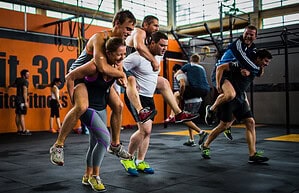TL;DR –
Whoever designed the combined conditioning programme needs to re-evaluate their conditioning programmes.
you don’t jump any lower or higher without shoes but it feels more comfortable in a trainer.
in season keeping training effective and time efficient can help to reduce the risk of injury sustained during games.
how hard and how long you stretch affects the success of your programme same as with every fitness attribute really.
as long as you use the same method of timing your 40 meter sprints it is valid within itself.
A total body resistance session consisting of 8 resistance exercises performed with 5 sets of 8-10 reps (320 to 400 total reps) can produce a pronounced cardiac effect!
Circuit training vs Combined Aerobic and Strength training for novices.
Myers et al looked at the effexct of an aerobic fitness training circuit using only body weight exercises vs a traditional programme that combined aerobic and resistance training as discrete components. 34 Sedentry females took part in the study they where split into the two respective conditions (17 combined and 17 circuit).
They followed a 3x a week training programme for 5 weeks. Pre and post testing involved a vo2 max test, wingate test muscular strength and endurance tests.
Vo2 Max improved 11% for circuits and nothing for combined. Wingate peak and relative power improved similarly for both groups (3-5%). Combined group improved their strength and endurance tests more than the circuit training group (chest 1RM +20% for and +30% for combined as an example).
Authors concluded that circuits offer better cardiovascular gains and comparative strength gains to traditional training programmes.
TL;DR – Whoever designed the combined conditioning programme needs to re-evaluate their conditioning programmes.
Effect of footwear condition on maximal jumping performance
Harry et al looked at the effects of 3 diffrent footwear conditions (barefoot, minimal shoe and cross training shoe) on jump performance in 2 jump types. 15 men took part in the trail where the researchers looked at Jump displacement, EMG (hgamstrings, calfs and quadriceps), Ground reaction forces and Reported comfort.
Subjects reported higher levels of comfort in the Cross training shoes vs the other two conditions.
No difference was found for jump height between any of the footwear conditions, some differences in muscle activation and timing were noticed between footwear.
TL;DR – you don’t jump any lower or higher without shoes but it feels more comfortable in a trainer.
Effect of time spent in High intensity Heart Rate zones and injury occurrence.
Owen et al looked at the effect of increased levels of time spent in high intensity training zones during a training week had on the injury rate in 23 professional soccer players.
They recorded data over 2 consecuative seasons. The study showed an incidence of 18.8 injuries per 1000 hours spent training. Significant co-relations where found between volume of time spent in High intensity training zones (90% MHR+) and injury rate (r=0.57). Deeper analysis showed time spent in Very High intensity zones (95%+ MHR) increased the odds of sustaining a match injury.
The importance of reducing injury in competitive matches is always a desirable attribute. Perhaps finding the minimum amount of High intensity training required to maintain fitness during the competitive season could help reduce match injury induced by fatigue.
TL;DR – in season keeping training effective and time efficient can help to reduce the risk of injury sustained during games.
Effect of 9 week high intensity stretching training on biceps and femoris architecture.
Freitas et al looked at the effects of an 8 week high intensity stretching protocol had on knee extension range of motion in passive flexion and bicep femoris fascicle length, fascicle angle and muscle thickness. The experimental group (n=5) took part in an average of assisted stretching sessions per week while the control group took part in none.
After 8 weeks the experimental group managed an increase in maximal ROM (+14.2 degrees) and a 12.33mm increase in bicep femoris fascicle length.
The intensity and duration of stretching should be accounted for when trying to have an effect on flexibility and muscular architecture.
TL;DR – how hard and how long you stretch affects the success of your programme same as with every fitness attribute really.
Aerobic capacity is associated with improved performance in a hockey specific fitness test.
Peterson et al looked at the relationship between performance of vo2 max test performed on a skating treadmill (is there any kind of treadmill they haven’t invented!) and repeated sprint performance or shift performance as it is termed in Hockey.
45 college hockey players took part in the test. Significant correlations where shown between vo2 max and second gate decrement and the final stage completed.
The authors concluded that aerobic capacity was related to repeated sprint performance and the final stage of the fitness test concluded.
TL;DR – Aerobically fit players are faster for longer and can reach higher levels on sport specific fitness tests.
Hand timing vs Electronic timing for the 40 yard dash Validity and Reliability.
81 american football players form the National division 1 league took part in 2 40 yard sprint trial each. Each trial was recorded by an electronic timer involving light gates and pressure start, 2 experienced hand timers and 4 novice hand timers.
Hand timing produced a significantly faster time than did electronic timing. Novice – 4.86 +/- 0.33 , Experienced – 4.9 +/- 0.3 and Electronic 5.12 +/- 0.35.
Relative reliability was extremely high for all conditions. Repeated 40 yard sprint times have a high repeatability regardless of timing methods used with hand timing producing faster times than electronic timing.
TL;DR – as long as you use the same method of timing your 40 meter sprints it is valid within itself.
Figueiredo et al looked at the effect of 1 set, 3 set and 5 sets of strength training on heart rate variability and blood pressure with eleven male volunteers who had a minimum of 6 months of previous strength training experience.
Each particiapant performed Bench press, lat pulldown, shoulder press, bicep curl, tricep extension, leg press, leg curl and leg extension in a random order for each of the three conditions. Subjects where given 72 hours of rest between each condition. They performed sets 8-10 reps at 70% of their previously determined 1RM.
Blood pressure and Heart rate variability was taken before and after each session. The 5 set protocol produced a greater hypotensive effect post exercise than the 1 or 3 set protocols.
The 5 set protocol also produced a substantial amount of cardiac stress as shown by heart rate variability. High volume resistance training could be a good intervention if the goal is to reduce blood pressure acutely after the session.
TL;DR – A total body resistance session consisting of 8 resistance exercises performed with 5 sets of 8-10 reps (320 to 400 total reps) can produce a pronounced cardiac effect!
Marc








